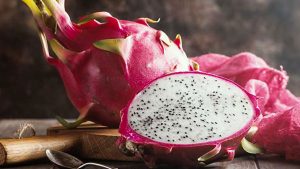
Whenever I travel, I try to live by the adage, “When in Rome … ” In Iceland I sampled pungent hákarl, or putrid shark, while in Cambodia I ate slithery snakehead fish. What lingers in my mind most is dragon fruit plucked fresh from the vine in Vietnam. Possessing hot pink skin; thick, green spines; black-specked white or rosy flesh; and a grenade-shaped body, the juicy dragon fruit remains one of the flashiest and most memorable foods around.
Thanks to a recent U.S. Department of Agriculture ruling, this flamboyant fruit no longer needs to be a mere memory for me. This spring, the U.S. began importing dragon fruit, or pitaya, from its native soil of Central America. Countries such as Belize, Honduras, Costa Rica and Panama can now stock U.S. markets with this exotic produce.
A member of the cactus family, dragon fruit thrives in tropical climates. Hence I could consume it in Vietnam and other parts of Southeast Asia. Likewise, the sultry weather in Latin America, the West Indies, California, Hawaii and Florida support its cultivation.
This nocturnal plant blooms under a full moon. In the wild, night creatures such as bats and moths pollinate its white-and-yellow flowers. On commercial farms, though, workers must go out after sundown and perform this task by hand.
For those who’ve never tried dragon fruit, this may seem like a lot of effort to grow such an odd-looking food. Trust me — it’s worth the work: This is a highly healthful and versatile treat.
Low in calories, dragon fruit serves up healthy doses of calcium; vitamins A, B, and C; and phosphorus. It’s also high in fiber, with 1 gram in 3 to 5 ounces of fresh fruit and roughly 10 grams in 3.5 ounces of dried fruit. A lot of nutritious eating gets packed into one small fruit.
Opinions differ on its flavor. To me, dragon fruit resembles a pleasant combination of kiwis, grapes, pears and a hint of vanilla. Others liken and refer to dragon fruit as a strawberry pear. I can see why. Similar to an unripe or winter pear, the mild flesh is a tad gritty but subtly sweet and juicy. Unlike a pear, its whitish or pinkish flesh is flecked with tiny, black, edible seeds reminiscent of a kiwi’s.
Light and refreshing, dragon fruit pairs well with a variety of foods. It goes nicely with ginger, lemon, lime, mango, mint, papaya, passion fruit, strawberries and seafood. It likewise has an affinity for balsamic vinegar and simple syrup.
You can eat dragon fruit raw, scooped directly from its skin, or cut up and added to salads. You can puree or juice it and add it to cocktails or make it into preserves. It does well in ice creams, sorbets, smoothies and even stir-frys. If you don’t want to tackle an entire fruit, you can enjoy it in commercially produced teas, fruit blends, liqueurs and energy drinks.
Dragon fruit can be found in Latin American and Asian markets as well as some gourmet shops. You can buy it fresh, canned or dried. In season from August to December, fresh dragon fruit should have blemish-free skin that yields when gently squeezed or pressed. Avoid those with bruised or withered skin.
Keep in mind that there are three varieties of dragon fruit, two of which have shocking magenta skin. If you see a yellow dragon fruit, don’t assume that it’s spoiled or unpalatable. It’s simply the white-fleshed variety of this fruit.
Placed in a plastic bag and refrigerated, fresh dragon fruit will keep for up to five days. To serve, cut the fruit in half and scoop out the flesh. You can also peel the fruit with a paring knife and then cut it into slices.




